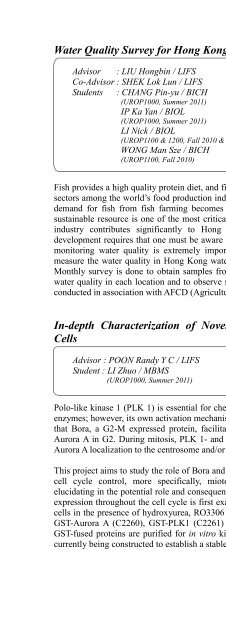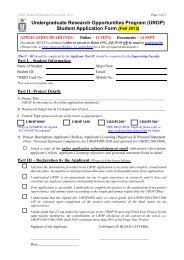UROP Proceedings 2010-11
UROP Proceedings 2010-11
UROP Proceedings 2010-11
Create successful ePaper yourself
Turn your PDF publications into a flip-book with our unique Google optimized e-Paper software.
Report on Lunar Crater ProjectAdvisorCo-AdvisorStudent: CHAN Kwing Lam / MATH: CHENG Siu Wing / CSE: ZHOU Rongrong / MAEC(<strong>UROP</strong><strong>11</strong>00, Summer 20<strong>11</strong>)The ultimate target of our project is to identify and categorize the crater patterns on the moonwith two sets of data: altimeter readings and photographic images. The goal is to complete thedownloading of the <strong>11</strong>-month CE data, test the data accuracy with principal crater plottingand preliminary processing. In this project, I am responsible for the study of three craters,namely, Copernicus, Sklodowska and Coriolis.The Evolution of RecombinationAdvisor : CHASNOV Jeffrey R / MATHStudent : YE Xiaofeng / MATH-AM(<strong>UROP</strong><strong>11</strong>00, Spring 20<strong>11</strong>)Selection is assumed to happen as a haploid and the genome contains L +1 diallelic loci, withL fitness loci and one recombination modifier locus. It is also assumed that the modifier genehas no impact on fitness, but changes the recombination rates of the fitness loci. In general,the modifier gene doesn’t need to be near the fitness loci so the recombination rate betweenthe modifier locus and the fitness loci is assumed to be a constant R. The alleles on themodifier locus are denoted by A and a. When both haplotypes have allele a, the recombinationrate between the fitness loci is r = r 1 . If only one of the haplotypes has allele A, the rate is r =r 2 , and if both haplotypes have allele A, the rate is r = r 3 . The case of two fitness loci under theLevene model for frequency-dependent selection is illustrated in this project.Efficient Numerical Methods for Dynamic InterfaceAdvisor : LEUNG Shing Yu / MATHStudent : HON Yu Sing / MATH-MP & PHYS-PM(<strong>UROP</strong><strong>11</strong>00, Fall <strong>2010</strong>)We propose new algorithms for modeling interface motions. The idea is to develop a newcell-based representation of the interface based on the “grid-based particle method for movinginterface problems” co-developed by Dr. Shingyu Leung. The algorithm composes of threeparts: initialization, motion and resampling. This part of the project concentrates on the firststep in which we propose a new interface representation. The interface is represented and istracked using numerous particles. These sampling particles are sampled based on cells closeto them, i.e. each particle is associated to a cell near the interface. Local information includingInterface velocity, arclength-element of the surface and other Lagrangian information on theinterface can be found naturally, while integrals on the surface can now be approximatedeasily by summing up all contributions from each small segments of the interface.13



